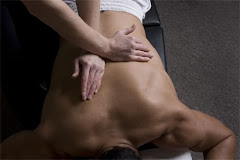While these stress chemicals served their purpose in caveman days, providing armament against attacks by wild beasts, the stress response may seem a bit over the top when all we are facing is gulping coffee on our way to work or listening to the news while stuck in traffic. Yet these chemicals may flow despite there being no real threat, and that's not something to trifle with.
For better health, we can draw on another tradition from ancient times, the elixir of relaxation known as massage. People who have tried massage report the experience to be almost overwhelmingly positive, whether they know the scientific reasons for it or not. Probably dating back to Puritan and Victorian times, we Americans still have an underlying inhibition about touch for its own sake. So basic is the need for it, though, when it finally occurs, that many massage clients encounter near-cathartic experiences on the massage table. At times, tears are shed as knots and strains start to unwind themselves and the body returns to its naturally peaceful state. Massage releases endorphins, the body's natural anesthetic, countering the cortisol and adrenaline the body releases in response to stress or a perceived threat.
We might ride the chemical roller coaster during the day as we try to pour 2 gallon's worth of activity into a 1-gallon container. We enter the massage room coiled like springs, wound tightly from driving, sitting in chairs, pushing shopping carts, and craning necks to hold a phone in place. All of this activity and a buildup of stress responses express themselves through the body. If one part of the posture is out of whack - say the shoulders are hunched forward - it throws off alignment throughout the rest of the structure. This adds up to tight muscles, compressed organs, pain and fatigue. Massage is one way to reclaim human contact while re-establishing balance and alignment.
The Science Behind Massage
For those who feel a bit undeserving of the pampering, full-body massage, there's enough science on the health benefits to ease even the strictest conscience. Massage has been shown in scientific studies to help with serious medical conditions, including reducing pain and anxiety in burn and cancer patients, and relieving pain from arthritis, fibromyalgia, osteoarthritis and surgery. It also can benefit people with eating disorders and Alzheimer's disease.
If your own medical condition isn't this serious, you'll be happy to know massage strengthens the immune system, makes workers more productive, improves sleep, and reduces angst and withdrawal symptoms in people trying to kick cigarette and alcohol addictions. There's other evidence massage relieves tension headaches, migraines, and lower back pain. Self-reported results indicate massage rules when it comes to soothing stress, decreasing anxiety, and improving self-esteem. If massage can provide such relief in the case of serious illness, how many more benefits can you reap when you're healthy, albeit somewhat frazzled?
In terms of stress, massage does much more than offset those stress chemicals; it also helps symptoms that are closely intertwined with the stress response. Evidence suggests massage improves circulation and joint mobility, lowers blood pressure, and improves energy and concentration. With better circulation, more oxygen and nutrients reach your vital organs and tissues, and more lymph fluid flows to fight off disease. Massage also improves muscle function, flexibility, and range of motion, and decreases muscle spasms and cramping.
Massage in the Mainstream
A study by the Touch Research Institute at the University of Miami showed less stress and improved performance for a small sample of employees (against a control group), who had twice-weekly, 15-minute massages in the office. We can thank Silicon Valley for introducing the idea of chair massage into the workplace as an employee benefit. Those West Coast innovators knew that happy employees were more productive.
Chair massage in the office is a wonderful way for those who've never tried massage to get a sample. Little wonder the Society for Human Resource Management reported in 2007 that 13 percent of its 210,000 member companies offer workplace massage, and an article in Working Mother magazine reported that 77 percent of the top 100 U.S. companies offer massage at work.
Another way chair massage has worked its way into the mainstream is its presence as an airport or mall amenity, places where people are often stressed, rushed, or sagging under the weight of luggage or shopping bags. Chair massage is performed completely clothed in a private or semiprivate kiosk, often for 10-20 minutes, and is a great introduction to massage for those with a sudden impulse to try something new and no desire to commit more than a few minutes.
An Adjunct to Exercise
People who look after their health also tend to exercise more, and exercise is an incredible stress reducer. The benefits of exercise can be exponentially more valuable when combined with massage. Many athletes use massage before an event, visualizing their best performance while activating corresponding muscles. Afterward, massage can reduce recovery time until the next event or workout. And of course, there's that glorious massage to relieve discomfort after you've overdone it on the tennis court, bike path or elliptical machine. As your massage therapist works out that lactic acid from your stiff muscles, you can relax and congratulate yourself on doing the right thing. As the old saying goes, it hurts, but it's a good kind of hurt. (Note: Tell your massage therapist if the pressure they're applying or a particular technique becomes too uncomfortable.) You can extend the wonders of exercise by combining it with strategically timed massage. Treating yourself to a massage is a wonderful reward for staying active and delivers a one-two punch to unwelcome stress.
The Promise of Prevention
Up to 90 percent of disease may be caused by stress. Perhaps nowhere can massage be more important for healthy people than in the prevention of innumerable ailments. At the very least, one can argue stress and its chemical agents play a role in making any infirmity worse, so dealing with stress proactively is an ounce of prevention in slowing or outright stopping disease in its tracks. Numerous studies have shown massage stimulates and strengthens the immune system. One study showed massage produced an increased number of natural killer cells, thought to defend the body against viral and cancer cells. What better evidence do you need that regular massage - some people aim for weekly or monthly regimes - should be part of your wellness planning?
More and more doctors are integrating massage therapy services into their practices. Talk to your doctor about the health consequences of stress and how massage and other types of natural therapy can help.
WE NOW HAVE A MASSAGE THERAPY AVAILABLE AND OUR PATIENTS ARE LOVING IT!
CALL US TODAY AND SCHEDULE YOUR MASSAGE! BUY ONE GET ONE FREE! ($40.00 VALUE)

















